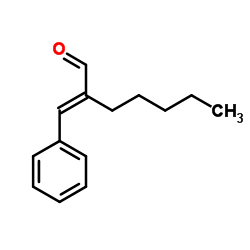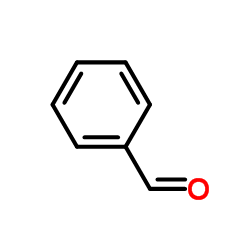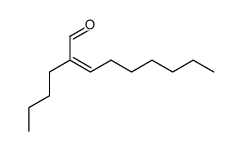122-40-7
| Name | Amylcinnamaldehyde |
|---|---|
| Synonyms |
2-Benzylideneheptanal
Amyl cinnamal FEMA 2061 Heptanal, 2-(phenylmethylene)-, (2E)- α-Amylcinnamaldehyde 2-Amyl-3-phenylacrylaldehyde JASMINAL Heptanal, 2-benzylidene- EINECS 204-541-5 (2E)-2-(phenylmethylidene)heptanal Cinnamaldehyde, α-pentyl- Heptanal, 2-(phenylmethylene) Heptanal, 2-(phenylmethylene)- α-Pentylcinnamaldehyde Jasminealde-hyde α-Amylcinnamic aldehyde Flomine 2-(Phenylmethylene)heptanal 2-Amyl-3-phenyl-2-propenal Jasminaldehyde MFCD00006988 2-(Phenylmethylene)-heptanal (2E)-2-Benzylideneheptanal Heptanal, 2- (phenylmethylene)- |
| Density | 1.0±0.1 g/cm3 |
|---|---|
| Boiling Point | 288.5±0.0 °C at 760 mmHg |
| Molecular Formula | C14H18O |
| Molecular Weight | 202.292 |
| Flash Point | 131.1±14.6 °C |
| Exact Mass | 202.135757 |
| PSA | 17.07000 |
| LogP | 4.80 |
| Vapour Pressure | 0.0±0.6 mmHg at 25°C |
| Index of Refraction | 1.534 |
|
SECTION 1: Identification of the substance/mixture and of the company/undertaking Product identifiers : α-Amylcinnamaldehyde Product name REACH No.: A registration number is not available for this substance as the substance or its uses are exempted from registration, the annual tonnage does not require a registration or the registration is envisaged for a later
registration deadline. CAS-No.: 122-40-7 Relevant identified uses of the substance or mixture and uses advised against Identified uses: Laboratory chemicals, Manufacture of substances SECTION 2: Hazards identification Classification of the substance or mixture Classification according to Regulation (EC) No 1272/2008 Skin sensitisation (Category 1), H317 Chronic aquatic toxicity (Category 2), H411 For the full text of the H-Statements mentioned in this Section, see Section 16. Classification according to EU Directives 67/548/EEC or 1999/45/EC Xi IrritantR43 N Dangerous for theR51/53 environment For the full text of the R-phrases mentioned in this Section, see Section 16. Label elements Labelling according Regulation (EC) No 1272/2008 Pictogram Signal wordWarning Hazard statement(s) H317May cause an allergic skin reaction. H411Toxic to aquatic life with long lasting effects. Precautionary statement(s) P273Avoid release to the environment. P280Wear protective gloves. Supplemental Hazardnone Statements Other hazards - none SECTION 3: Composition/information on ingredients Substances Formula: C14H18O Molecular Weight: 202,29 g/mol CAS-No.: 122-40-7 EC-No.: 204-541-5 Hazardous ingredients according to Regulation (EC) No 1272/2008 ComponentClassificationConcentration α-Amylcinnamaldehyde CAS-No.122-40-7Skin Sens. 1; Aquatic Chronic<= 100 % EC-No.204-541-52; H317, H411 Hazardous ingredients according to Directive 1999/45/EC ComponentClassificationConcentration α-Amylcinnamaldehyde CAS-No.122-40-7Xi, N, R43 - R51/53<= 100 % EC-No.204-541-5 For the full text of the H-Statements and R-Phrases mentioned in this Section, see Section 16 SECTION 4: First aid measures Description of first aid measures General advice Consult a physician. Show this safety data sheet to the doctor in attendance. If inhaled If breathed in, move person into fresh air. If not breathing, give artificial respiration. Consult a physician. In case of skin contact Wash off with soap and plenty of water. Consult a physician. In case of eye contact Flush eyes with water as a precaution. If swallowed Never give anything by mouth to an unconscious person. Rinse mouth with water. Consult a physician. Most important symptoms and effects, both acute and delayed The most important known symptoms and effects are described in the labelling (see section 2.2) and/or in section 11 Indication of any immediate medical attention and special treatment needed no data available SECTION 5: Firefighting measures Extinguishing media Suitable extinguishing media Use water spray, alcohol-resistant foam, dry chemical or carbon dioxide. Special hazards arising from the substance or mixture Carbon oxides Advice for firefighters Wear self contained breathing apparatus for fire fighting if necessary. Further information no data available SECTION 6: Accidental release measures Personal precautions, protective equipment and emergency procedures Use personal protective equipment. Avoid breathing vapours, mist or gas. Ensure adequate ventilation. For personal protection see section 8. Environmental precautions Prevent further leakage or spillage if safe to do so. Do not let product enter drains. Discharge into the environment must be avoided. Methods and materials for containment and cleaning up Soak up with inert absorbent material and dispose of as hazardous waste. Keep in suitable, closed containers for disposal. Reference to other sections For disposal see section 13. SECTION 7: Handling and storage Precautions for safe handling Avoid contact with skin and eyes. Avoid inhalation of vapour or mist. For precautions see section 2.2. Conditions for safe storage, including any incompatibilities Store in cool place. Keep container tightly closed in a dry and well-ventilated place. Containers which are opened must be carefully resealed and kept upright to prevent leakage. Recommended storage temperature: 2 - 8 °C Air sensitive. Specific end use(s) Apart from the uses mentioned in section 1.2 no other specific uses are stipulated SECTION 8: Exposure controls/personal protection Control parameters Components with workplace control parameters Exposure controls Appropriate engineering controls Handle in accordance with good industrial hygiene and safety practice. Wash hands before breaks and at the end of workday. Personal protective equipment Eye/face protection Face shield and safety glasses Use equipment for eye protection tested and approved under appropriate government standards such as NIOSH (US) or EN 166(EU). Skin protection Handle with gloves. Gloves must be inspected prior to use. Use proper glove removal technique (without touching glove's outer surface) to avoid skin contact with this product. Dispose of contaminated gloves after use in accordance with applicable laws and good laboratory practices. Wash and dry hands. The selected protective gloves have to satisfy the specifications of EU Directive 89/686/EEC and the standard EN 374 derived from it. Body Protection Complete suit protecting against chemicals, The type of protective equipment must be selected according to the concentration and amount of the dangerous substance at the specific workplace. Respiratory protection Where risk assessment shows air-purifying respirators are appropriate use a full-face respirator with multi-purpose combination (US) or type ABEK (EN 14387) respirator cartridges as a backup to engineering controls. If the respirator is the sole means of protection, use a full-face supplied air respirator. Use respirators and components tested and approved under appropriate government standards such as NIOSH (US) or CEN (EU). Control of environmental exposure Prevent further leakage or spillage if safe to do so. Do not let product enter drains. Discharge into the environment must be avoided. SECTION 9: Physical and chemical properties Information on basic physical and chemical properties a) AppearanceForm: viscous Colour: yellow b) Odourno data available c) Odour Thresholdno data available d) pHno data available e) Melting point/freezingMelting point/range: < 0 °C point f) Initial boiling point and 287 - 290 °C - lit. boiling range g) Flash point146 °C h) Evapouration rateno data available i) Flammability (solid, gas) no data available j) Upper/lowerno data available flammability or explosive limits k) Vapour pressure0,1 hPa at 50 °C l) Vapour densityno data available m) Relative density0,97 g/cm3 at 25 °C n) Water solubilityca.8,6 g/l o) Partition coefficient: n- log Pow: 4,7 octanol/water p) Auto-ignition231 °C temperature q) Decompositionno data available temperature r) Viscosityno data available s) Explosive propertiesno data available t) Oxidizing propertiesno data available Other safety information no data available SECTION 10: Stability and reactivity Reactivity no data available Chemical stability Stable under recommended storage conditions. Possibility of hazardous reactions no data available Conditions to avoid no data available Incompatible materials Strong bases, Strong oxidizing agents Hazardous decomposition products Other decomposition products - no data available In the event of fire: see section 5 SECTION 11: Toxicological information Information on toxicological effects Acute toxicity LD50 Oral - rat - 3.730 mg/kg Remarks: Sense Organs and Special Senses (Nose, Eye, Ear, and Taste):Olfaction:Other changes. Sense Organs and Special Senses (Nose, Eye, Ear, and Taste):Eye:Other. Behavioral:Somnolence (general depressed activity). Inhalation: no data available LD50 Dermal - rabbit - > 2.000 mg/kg Skin corrosion/irritation Skin - Human Result: No skin irritation Serious eye damage/eye irritation no data available Respiratory or skin sensitisation no data available Germ cell mutagenicity Result: Not mutagenic in Ames Test. Carcinogenicity IARC:No component of this product present at levels greater than or equal to 0.1% is identified as probable, possible or confirmed human carcinogen by IARC. Reproductive toxicity no data available Specific target organ toxicity - single exposure no data available Specific target organ toxicity - repeated exposure no data available Aspiration hazard no data available Additional Information RTECS: GD6825000 To the best of our knowledge, the chemical, physical, and toxicological properties have not been thoroughly investigated. SECTION 12: Ecological information Toxicity Toxicity to fishLC50 - Danio rerio (zebra fish) - 3 mg/l - 96 h (OECD Test Guideline 203) Toxicity to daphnia and EC50 - Daphnia magna (Water flea) - 1,1 mg/l - 48 h other aquatic invertebrates Toxicity to algaeEC50 - Algae - 1,89 mg/l - 72 h Persistence and degradability BiodegradabilityResult: - Readily biodegradable. (OECD Test Guideline 301B) Bioaccumulative potential no data available Mobility in soil no data available Results of PBT and vPvB assessment PBT/vPvB assessment not available as chemical safety assessment not required/not conducted Other adverse effects Toxic to aquatic life with long lasting effects. SECTION 13: Disposal considerations Waste treatment methods Product Offer surplus and non-recyclable solutions to a licensed disposal company. Contaminated packaging Dispose of as unused product. SECTION 14: Transport information UN number ADR/RID: 3082IMDG: 3082IATA: 3082 UN proper shipping name ADR/RID: ENVIRONMENTALLY HAZARDOUS SUBSTANCE, LIQUID, N.O.S. (α-Amylcinnamaldehyde) ENVIRONMENTALLY HAZARDOUS SUBSTANCE, LIQUID, N.O.S. (α-Amylcinnamaldehyde) IMDG: Environmentally hazardous substance, liquid, n.o.s. (α-Amylcinnamaldehyde) IATA: Transport hazard class(es) ADR/RID: 9IMDG: 9IATA: 9 Packaging group ADR/RID: IIIIMDG: IIIIATA: III Environmental hazards ADR/RID: yesIMDG Marine pollutant: yesIATA: yes Special precautions for user Further information EHS-Mark required (ADR 2.2.9.1.10, IMDG code 2.10.3) for single packagings and combination packagings containing inner packagings with Dangerous Goods > 5L for liquids or > 5kg for solids. SECTION 15 - REGULATORY INFORMATION N/A SECTION 16 - ADDITIONAL INFORMATION N/A |
CHEMICAL IDENTIFICATION
HEALTH HAZARD DATAACUTE TOXICITY DATA
|
| Symbol |


GHS07, GHS09 |
|---|---|
| Signal Word | Warning |
| Hazard Statements | H317-H411 |
| Precautionary Statements | P273-P280 |
| Personal Protective Equipment | Faceshields;full-face respirator (US);Gloves;Goggles;multi-purpose combination respirator cartridge (US);type ABEK (EN14387) respirator filter |
| Hazard Codes | Xi:Irritant |
| Risk Phrases | R36/37/38 |
| Safety Phrases | S26-S37/39 |
| RIDADR | UN 3082 9 / PGIII |
| WGK Germany | 2 |
| RTECS | GD6825000 |
| HS Code | 2912299000 |
|
~87% 
122-40-7 |
| Literature: Vermoortele, Frederik; Ameloot, Rob; Vimont, Alexandre; Serre, Christian; De Vos, Dirk Chemical Communications, 2011 , vol. 47, # 5 p. 1521 - 1523 |
|
~% 
122-40-7 |
| Literature: Organic Letters, , vol. 12, # 5 p. 948 - 951 |
|
~% 
122-40-7 |
| Literature: Applied Catalysis A: General, , vol. 466, p. 38 - 44 |
|
~% 
122-40-7
Detail
|
| Literature: Applied Catalysis A: General, , vol. 466, p. 38 - 44 |
|
~% 
122-40-7 |
| Literature: Journal fuer Praktische Chemie (Leipzig), , vol. <2> 119, p. 274 Zhurnal Russkago Fiziko-Khimicheskago Obshchestva, , vol. 60, p. 927 |
| Precursor 3 | |
|---|---|
| DownStream 1 | |
| HS Code | 2912299000 |
|---|---|
| Summary | 2912299000. other cyclic aldehydes without other oxygen function. VAT:17.0%. Tax rebate rate:13.0%. . MFN tariff:5.5%. General tariff:30.0% |








